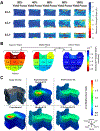Trabecular Architecture and Mechanical Heterogeneity Effects on Vertebral Body Strength
- PMID: 33215364
- PMCID: PMC7891914
- DOI: 10.1007/s11914-020-00640-0
Trabecular Architecture and Mechanical Heterogeneity Effects on Vertebral Body Strength
Abstract
Purpose of review: We aimed to synthesize the recent work on the intra-vertebral heterogeneity in density, trabecular architecture and mechanical properties, its implications for fracture risk, its association with degeneration of the intervertebral discs, and its implications for implant design.
Recent findings: As compared to the peripheral regions of the centrum, the central region of the vertebral body exhibits lower density and more sparse microstructure. As compared to the anterior region, the posterior region shows higher density. These variations are more pronounced in vertebrae from older persons and in those adjacent to degenerated discs. Mixed results have been reported in regard to variation along the superior-inferior axis and to relationships between the heterogeneity in density and vertebral strength and fracture risk. These discrepancies highlight that, first, despite the large amount of study of the intra-vertebral heterogeneity in microstructure, direct study of that in mechanical properties has lagged, and second, more measurements of vertebral loading are needed to understand how the heterogeneity affects distributions of stress and strain in the vertebra. These future areas of study are relevant not only to the question of spine fractures but also to the design and selection of implants for spine fusion and disc replacement. The intra-vertebral heterogeneity in microstructure and mechanical properties may be a product of mechanical adaptation as well as a key determinant of the ability of the vertebral body to withstand a given type of loading.
Keywords: Density; Intervertebral disc; Loading; Microstructure; Vertebra.
Conflict of interest statement
Conflict of Interest
The authors declare no conflict of interest.
Figures



References
-
- Mosekilde L (1998) The effect of modelling and remodelling on human vertebral body architecture. Technol Heal Care 6:287–297 - PubMed
-
- Ulrich D, Van Rietbergen B, Laib A, Rueegsegger P (1999) The ability of three-dimensional structural indices to reflect mechanical aspects of trabecular bone. Bone 25:55–60 - PubMed
-
- Carter DR, Hayes WC (1976) Bone compressive strength: the influence of density and strain rate. Science (80- ) 194:1174–1176 - PubMed
Publication types
MeSH terms
Grants and funding
LinkOut - more resources
Full Text Sources
Research Materials

